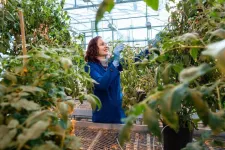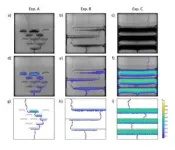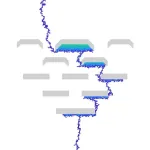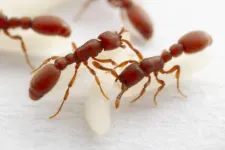(Press-News.org) iobhan Brady, a professor in the Department of Plant Biology and Genome Center at the University of California, Davis, has been selected as a Howard Hughes Medical Institute (HHMI) Investigator. The prestigious Investigator program, which Brady describes as “life changing,” will provide her with roughly $9 million in research support over a seven-year term, with the option to renew.
Brady’s research aims to understand how plants use their roots to respond to environmental stressors, and to use this information to develop plants that are better able to respond to climate change. To do this, Brady’s lab employs a range of techniques, from genomic and cellular analysis to evolutionary comparisons. With HHMI’s support, she will be able to expand her research scope to explore roots in new and boundary-pushing ways.
“It's the kind of opportunity that will allow me to do really bold science—high-risk, high-reward research,” Brady said. “I actually couldn't believe it was real. It was only after I read it out to my husband that I was like, okay, now it's really real.”
Brady joins two other HHMI Investigators at UC Davis—Neil Hunter in the Department of Microbiology and Molecular Genetics and Jorge Dubcovsky in the Department of Plant Sciences.
The root of the problem
Brady has been fascinated by plant roots since she was in graduate school, when she spent hours poring over them with a microscope. Roots are the primary mechanism by which plants obtain water and nutrients, but researchers still know relatively little about the cells, molecules, and genes that are involved in these processes outside of the most researched plant species.
“Roots are intricate and beautiful, and they have all of these secrets that we want to unlock,” Brady said. “There are so many root features that we know exist, but we still have no idea how they’re made or what they do.”
Brady hopes to develop a toolbox of resources that will help deepen our understanding of how plants have evolved to respond to dynamic environments. These include changes in nutrients, water availability as well as the presence of other helpful and harmful organisms. Once understood, scientists can apply this information to the creation of plants that are more resilient to climate change.
“My lab focuses on systematically uncovering the genetic programs that are responsible for where, when, and how these cell types and their walls are formed, and how they function in relation to the environment,” Brady said. “Our ultimate goal is to mitigate the havoc that climate change is already wreaking on our planet.”
The opportunity to grow (and put down roots)
Unlike other sources of research funding, the HHMI Investigator program funds “people, not projects,” which means that Brady will be able to pursue multiple research avenues simultaneously, and to develop long-term projects that would be beyond the lifespan of a typical funding cycle.
Brady is eager to incorporate new techniques and technologies into her lab’s research, including engineering and biomaterials research, to grow her team, and to explore research questions and plant systems that were previously inaccessible.
“I get to dream and put together a really great group of people who can delve into new, bold questions,” Brady said.
Being an HHMI Investigator also opens up opportunities for Brady to network and collaborate with other Investigators, who include world-renowned researchers at over 60 US institutions. Once a year, she—and one graduate or postdoctoral trainee from her lab—will have the chance to attend an HHMI research meeting.
“These meetings will be an amazing opportunity for us to have conversations and network and collaborate with a really incredible group of researchers who do very different and out-of-the-box research,” Brady said.
Brady is grateful for the support of her lab group and colleagues at UC Davis, without whom she says she would never have been granted this opportunity.
“The work I do is only possible because of the people in my lab and their ideas and how hard they work,” said Brady. “It also wouldn’t have been possible without the university’s support and the collegial environment that I've been lucky to grow and thrive in.”
END
Plant Biologist Siobhan Brady named HHMI Investigator
2024-07-23
ELSE PRESS RELEASES FROM THIS DATE:
Long-acting injectable cabotegravir for HIV prevention is safe in pregnancy
2024-07-23
Long-acting injectable cabotegravir (CAB-LA) was safe and well tolerated as HIV pre-exposure prophylaxis (PrEP) before and during pregnancy in the follow-up phase of a global study among cisgender women. The analysis of outcomes from more than 300 pregnancies and infants will be presented at the 2024 International AIDS Conference (AIDS 2024) in Munich, Germany.
“Cisgender women experience biological changes and social dynamics that can increase their likelihood of acquiring HIV during pregnancy and the postnatal period, and we need to offer them evidence-based options when they may need them most,” said Jeanne Marrazzo, M.D., M.P.H., ...
Large language models don’t behave like people, even though we may expect them to
2024-07-23
CAMBRIDGE, MA – One thing that makes large language models (LLMs) so powerful is the diversity of tasks to which they can be applied. The same machine-learning model that can help a graduate student draft an email could also aid a clinician in diagnosing cancer.
However, the wide applicability of these models also makes them challenging to evaluate in a systematic way. It would be impossible to create a benchmark dataset to test a model on every type of question it can be asked.
In a new paper, MIT researchers took a different approach. They ...
NREL researchers highlight opportunities for manufacturing perovskite solar panels with a long-term vision
2024-07-23
Researchers working at the forefront of an emerging photovoltaic (PV) technology are thinking ahead about how to scale, deploy, and design future solar panels to be easily recyclable.
Solar panels made of perovskites may eventually play an important role amid global decarbonization efforts to reduce greenhouse gas emissions. As the technology emerges from the testing stages, it is a perfect time to think critically about how best to design the solar panels to minimize their impact on the environment decades from now.
“When you have a technology in its very early stages, you have the ability to design it better. It’s a cleaner slate,” said Joey Luther, a senior ...
Top Medicare advantage plans less available in disadvantaged areas
2024-07-23
Looking for a Medicare Advantage plan with a five-star quality rating? You’re less likely to find one available to you if you live in a county with higher poverty and unemployment, finds a new study published in JAMA Network Open.
These geographic disparities may be contributing to unequal health outcomes and limiting federal funds from reaching the regions most in need, according to the researchers.
“What this means is that Medicare beneficiaries living in counties with greater social disadvantage ...
Better carbon storage better carbon storage with stacked geology with stacked geology
2024-07-23
The overarching goal of all carbon capture and storage projects is the same: Keep carbon dioxide (CO2) emissions out of the atmosphere by storing them in the subsurface for good.
One way to do that is to inject the CO2 into a reservoir space that’s covered with a big lid – an impermeable caprock that can keep the gas in place and stop any upward flow in its tracks. That’s the model that petroleum exploration has relied on for decades when searching for oil traps, and it works for both oil and CO2. But according to research led by The University of Texas at Austin’s Bureau of Economic Geology, subsurface ...
Sharp temperature reduction for quantum dots in polymer by highly efficient heat dissipation pathways
2024-07-23
A new publication from Opto-Electronic Advances; DOI 10.29026/oea.2024.240036 , discusses sharp temperature reduction for quantum dots in polymer by highly efficient heat dissipation pathways.
Quantum dots (QDs), a kind of luminescent nanocrystals featuring size-tunable emission spectra and superior color purity are widely applied in optoelectronic fields. However, these particles are facing luminous efficiency degradation due to their temperature-sensitive characteristic and the high temperature in optoelectronic ...
UAF researcher creates way to detect elusive volcanic vibrations
2024-07-23
A new automated system of monitoring and classifying persistent vibrations at active volcanoes can eliminate the hours of manual effort needed to document them.
Graduate student researcher Darren Tan at the University of Alaska Fairbanks Geophysical Institute led development of the system, which is based on machine learning. Machine learning is a branch of artificial intelligence focused on building systems that learn from data, identify patterns and make decisions with minimal human intervention.
Details about Tan’s automated ...
Lissajous pattern multi-pass cell: Enhancing high sensitivity and simultaneous dual-gas LITES sensing
2024-07-23
A new publication from Opto-Electronic Sciences; DOI 10.29026/oes.2024.240013 , discusses highly sensitive and real-simultaneous CH4/C2H2 dual-gas LITES sensor based on Lissajous pattern multi-pass cell.
Trace gases are atmospheric constituents with a volume fraction of less than 1%. Despite their low concentrations, nitrogen oxides, hydrocarbons, and sulfides in the atmosphere have a significant impact on the environment, closely related to phenomena such as acid rain, greenhouse effects, and ozone layer depletion. Therefore, race gas detection of is crucial for environmental ...
Asexual reproduction usually leads to a lack of genetic diversity. Not for these ants.
2024-07-23
Genetic diversity is essential to the survival of a species. It’s easy enough to maintain if a species reproduces sexually; an egg and a sperm combine genetic material from two creatures into one, forming a genomically robust offspring with two distinct versions of the species’ genome.
Without that combination of different genetic makeups, asexually reproducing species typically suffer from a lack of diversity that can doom them to a limited run on Earth. One such animal should be the clonal raider ant, which produces daughter after genetically identical daughter directly from an unfertilized ovum ...
Mini lungs make major COVID-19 discoveries possible
2024-07-23
Scientists at Sanford Burnham Prebys, University of California San Diego and their international collaborators have reported that more types of lung cells can be infected by SARS-CoV-2 than previously thought, including those without known viral receptors. The research team also reported for the first time that the lung is capable of independently mustering an inflammatory antiviral response without help from the immune system when exposed to SARS-CoV-2.
This work is especially timely, as cases of COVID-19 are on the rise in the scientists’ hometown of San Diego during a summertime spike. Looking beyond the region, more than half of the states in the country have reported “very ...







